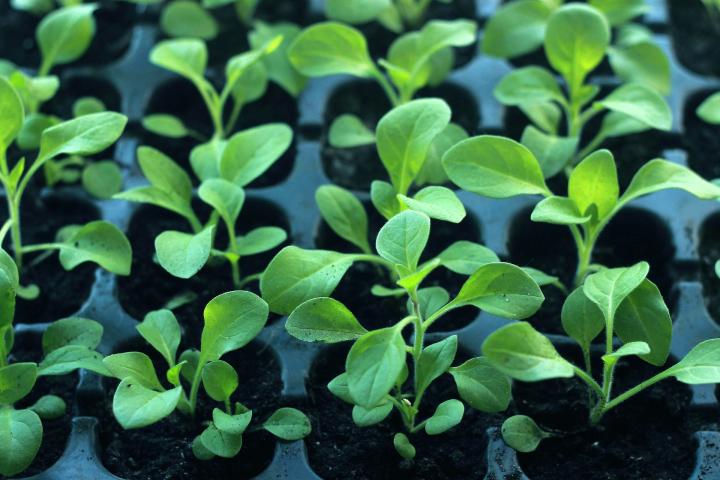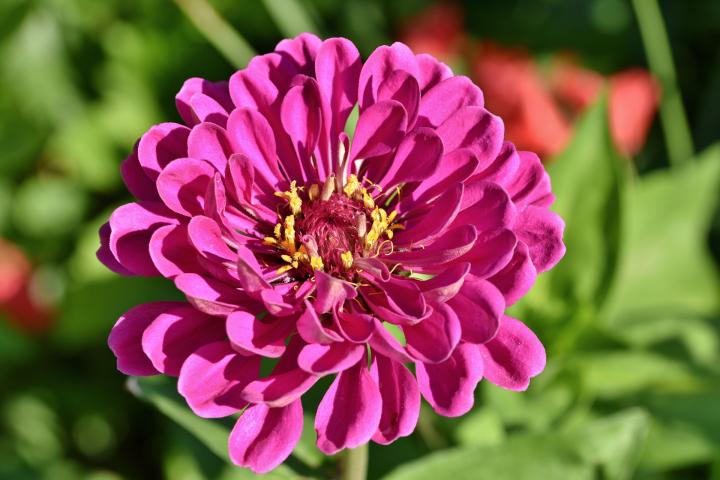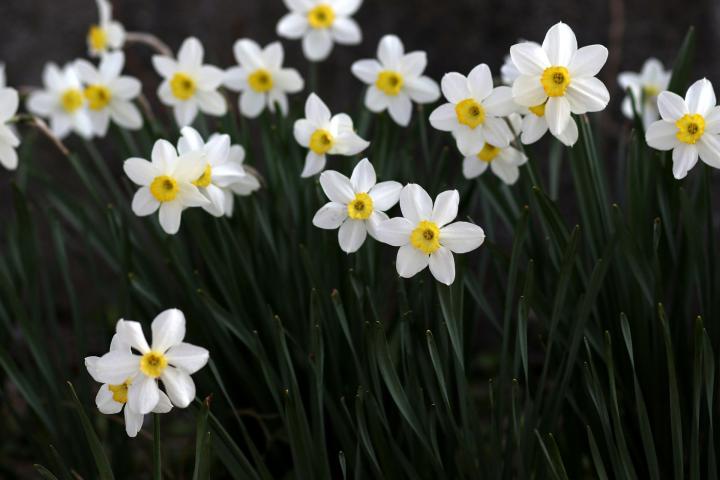A Guide to Planting Annuals, Perennials, and Bulbs
When do you plant flowers in the garden? It depends! Is it a perennial flower, annual flower, or bulb? Is it frost-sensitive or not? As with vegetables, there’s a right and a wrong time to plant your favorite flowers. See our When to Plant Flowers charts with information on when to start seeds and when transplant young plants outdoors.
ADVERTISEMENT
Different plants need a different amount of lead time before they are ready to transplant into the garden. Starting too soon can result in a weak, lanky plant, while starting too late can give you one that is just not ready for the outside world—both will struggle to survive! Here’s what you should take into consideration before planting.
Know Your Frost Date
Before you even think of starting seeds, you need to know your area’s spring (and fall) frost dates. Planting schedules like the one below or our Vegetable Planting Calendar rely on frost dates to determine when it’s safest to ultimately plant outdoors, since young plants are more susceptible to a freeze.
 Strong seedlings are one of the keys to a successful flower garden.
Strong seedlings are one of the keys to a successful flower garden.Perennial Flowers
Perennials are plants that are capable of surviving two or more years. While they may die back to the ground in winter, their roots survive underground and produce new foliage as the increased light and warmth of spring arrives. Most perennials will bloom in the same year that they are planted, while others may need to spend time becoming established first (particularly if planted later in the growing season).
Start Seeds in the Spring
Some perennials can be challenging to start from seed, but most are fairly easy to grow and make for an inexpensive way to fill up a new flower bed. Some seeds will need a period of cold temperatures before they will germinate and may also take a longer time to germinate—3-4 weeks is not unusual—so they should be started earlier than others. Follow the instructions given on your seed packet.
Plant Mature Perennials in the Fall
If you’re planning on adding mature perennial plants (such as those bought from a nursery) to your garden, the best time to plant is in the fall. Plant them at least six weeks before your first fall frost date in order to give them time to settle in before winter. Roots will still grow while temperatures are in the 40s (Fahrenheit). Read all about planting and caring for perennials here!
When to Start Perennial Flower Seeds
FlowerStart Seeds Indoors (Weeks Before Last Frost Date)Plant OutdoorsAnise Hyssop8-10 weeksOn last frost dateAsclepias (Milkweed)10-12 weeks1-2 weeks after last frostCatmint8-10 weeksOn last frost dateColumbine8-10 weeksOn last frost dateCoreopsis8-10 weeksOn last frost dateDaisy10-12 weeks1-2 weeks before last frostDelphinium (perennial)10-12 weeks1-2 weeks before last frostDianthus10-12 weeks1-2 weeks before last frostEchinacea (Coneflower)8-10 weeksOn last frost dateFoxglove (Digitalis)10-12 weeks1-2 weeks after last frostGaillardia8-10 weeksOn last frost dateHelianthus8-10 weeksOn last frost dateHeliopsis10-12 weeks1-2 weeks after last frostHibiscus8-10 weeks1-2 weeks after last frostHollyhock8-10 weeksOn last frost dateMonarda (Bee Balm)8-10 weeksOn last frost datePhlox (perennial)10-12 weeks1-2 weeks after last frostRudbeckia (Black-Eyed Susan)8-10 weeks1-2 weeks before last frostThyme8-10 weeksOn last frost dateViola8-10 weeks1-2 weeks before last frostYarrow8-10 weeksOn last frost dateHow Long Do Perennials Take to Grow?
8-10 Weeks
Many perennials take 8-10 weeks to reach a good size and can be transplanted on or after the last frost date:
- Anise hyssop, catmint, columbine, coreopsis, echinacea, gaillardia, helianthus, hollyhock, monarda, thyme, and yarrow.
Rudbeckia and violas are a little hardier and can go out in the garden 1-2 weeks before the last frost. Perennial hibiscus, on the other hand, need to wait 1-2 weeks after the frost free date has passed.
10-12 Weeks
Daisies, delphinium, and dianthus should be started 10-12 weeks ahead and can be planted out 1-2 weeks before the frost free date.
Asclepias, foxglove, heliopsis, and phlox take 10-12 weeks, but need to wait until after the last frost to be transplanted.
 Zinnias are fast-growing annuals that can be started indoors or seeded directly in the garden.
Zinnias are fast-growing annuals that can be started indoors or seeded directly in the garden.Annual Flowers
Annuals are plants that sprout, grow, bloom, and go to seed all in one season and only for one season. When winter comes, the plant dies, relying on its many seeds to germinate in the following spring. Because of this, most annual flowers are easy to grow from seed, taking about 6-8 weeks to grow to a transplantable size, though there are always exceptions to the rule. Some seeds may just take longer to germinate and slower-growing annuals will need to be started earlier. (Be sure to read the backs of your seed packets for plant- and variety-specific recommendations!)
Since most annuals are frost tender, you’ll need to wait until after the last spring frost date to transplant them into your garden. Below, you’ll find a table listing common annuals, as well as when to start their seeds and when to plant them outdoors. Remember to harden plants off before setting them outside!
When to Start Annual Flower Seeds
FlowerStart Seeds Indoors (Weeks Before Last Frost Date)Plant OutdoorsAllium6-8 weeksOn last frost dateAgeratum6-8 weeksOn last frost dateAlyssum6-8 weeks1-2 weeks before last frostAster6-8 weeksOn last frost dateBachelor Button6-8 weeksOn last frost dateCalendula6-8 weeks1-2 weeks before last frostCelosia6-8 weeksOn last frost dateColeus8-10 weeks1-2 weeks after last frostCosmos6-8 weeksOn last frost dateDelphinium (annual)6-8 weeks1-2 weeks before last frostGomphrena6-8 weeksOn last frost dateImpatiens8-10 weeks1-2 weeks after last frostMarigolds6-8 weeksOn last frost dateMorning Glory*3-4 weeksAfter last frostNicotiana6-8 weeksOn last frost datePetunia8-10 weeksOn last frost datePhlox (annual)8-10 weeksOn last frost dateSalvia6-8 weeksOn last frost dateScabiosa6-8 weeksOn last frost dateSnapdragon8-10 weeksOn last frost dateStatice6-8 weeksOn last frost dateStock8-10 weeksOn last frost dateStrawflower6-8 weeksOn last frost dateSunflower*3-4 weeks1-2 weeks after last frostVerbena8-10 weeksOn last frost dateZinnia*4-6 weeks1-2 weeks after last frost*These fast-growing annuals are often started outdoors after the danger of frost has passed.
How Long Do Annuals Take to Grow?
3-6 Weeks
Speedy annuals such as morning glories and sunflowers may take only 3-4 weeks to reach a transplantable size. Zinnias only need a 4- to 6-week head start and can be transplanted outdoors after your last spring frost date. Alternatively, these fast-growing annuals can be directly sown in the garden after the danger of frost has passed.
6-8 Weeks
Annuals that take 6-8 weeks to grow and can go out when the frost free date arrives include:
- Ageratum, asters, bachelor buttons, celosia, cosmos, gomphrena, marigolds, nicotiana, salvia, scabiosa, statice, and strawflowers.
Alyssum, calendula, and delphiniums also take about 6-8 weeks to grow, but these can go outside a little earlier: 1-2 weeks before the last frost.
8-10 Weeks
These annuals are slower to germinate and take 8-10 weeks to reach a good size for the garden. They can go out on the frost free date:
- Petunias, phlox, snapdragons, stock, and verbena.
Coleus and impatiens also take 8-10 weeks but are little more tender and need to be transplanted a week or two after the last frost date.
 Daffodils and other spring bulbs don’t bloom well when crowded.
Daffodils and other spring bulbs don’t bloom well when crowded.Spring and Summer Bulbs
Planting bulbs is another lovely way to add seasonal pops of color to your garden. We divide bulbs into two main categories: spring-flowering bulbs and summer-flowering bulbs.
- Spring-flowering bulbs are those that bloom from early spring to early summer. Included in this category are flowers like tulips, crocuses, and daffodils.
- Summer-flowering bulbs are those that bloom from early summer to early fall. Included in this category are flowers like gladiolus, dahlias, and cannas.
Generally speaking, spring-flowering bulbs should be planted in the fall (a few weeks before first frost), while summer-flowering bulbs should be planted in the spring (a few weeks after last frost). Why? In many cases, summer-flowering bulbs are not hardy enough to survive winter outdoors, while spring-flowering bulbs may actually need a period of colder weather to trigger their spring blooms. There are exceptions, of course! Hardy perennials that flower in the summer, like daylilies, can be planted in the spring or fall.
What Makes a Bulb a Bulb?
Not all “bulbs” are actually bulbs! A true bulb is a specific type of underground storage structure—think onions, tulips, and daffodils. Many popular “bulbs” are actually other types of structures, like corms (gladiolus), rhizomes (irises, daylilies), and tubers (dahlias). However, most gardeners simply refer to this entire category of plants as “bulbs” to make things a little easier!
When to Plant Bulbs
Bulbs to Plant in the FallBulbs to Plant in the SpringAlliumBegonia (tuberous)AnemoneCaladiumBluebell (Hyacinthoides)Calla LilyCrocusCannaDaffodilDahliaFritillariaDaylily*Glory-of-the-Snow (Chionodoxa)CrocosmiaGrape Hyacinth (Muscari)Elephant EarHyacinth (Hyacinthus)FreesiaIris*GladiolusSnowdrop (Galanthus)Lily, Asiatic/Oriental (Lilium)Squill (Scilla) Tulip*This hardy perennial may be planted in the spring or fall.
Caring for Bulbs
Wait until spring-flowering bulbs have finished blooming and their foliage has died back before digging, dividing, or moving them around. Mark their locations with brightly-colored popsicle sticks so you can find them more easily in late summer or early fall, which is the time to divide and transplant. Read more about spring-flowering bulbs.
Fall is also the time to dig up summer-flowering bulbs that need to be stored inside for winter. Read more about growing summer-flowering bulbs here!
What flowers will you grow next season? Let us know in the comments!
Comments